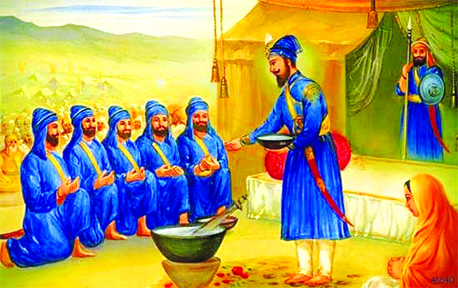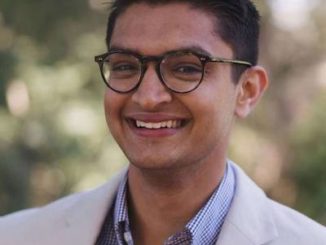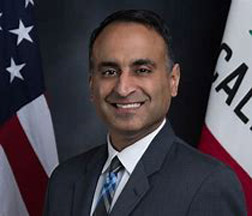
Khalsa, the purified and reconstituted Sikh community instituted by Guru Gobind Singh on March 30, 1699, on (Baisakhi Day. His declaration had three dimensions: it redefined the concept of authority within the Sikh community; it introduced a new initiation ceremony and code of conduct; and it provided the community with a new religious and political vision. Khalsa is used to denote both the body of initiated Sikhs and the community of all Sikhs.
The early Sikh community had been shaped by three levels of authority: the masands (“Guru’s deputies”) were responsible for local congregations; the Guru was the active central authority; and the revealed word as recorded in Sikh scriptural text served as the symbolic base. With the establishment of the Khalsa, the authority of the masands was eliminated. They were expected either to become members of the community on a par with all others or to leave the fold.
Guru Gobind Singh also introduced a new initation rite. More commonly called amrit pahul (“the nectar ceremony”) but also known as khande ki pahul (literally, “ceremony of the double-edged sword”), it was centred on a belief in the transformative power of the revealed word. The word was recited while water for initiation was stirred with a double-edged sword. Every Sikh who underwent the ceremony became a member of the Khalsa, was assigned the name Singh (“Lion”), and was expected to observe a rigorous code of conduct (rahit) symbolized by the wearing of five items: kes (long hair), kangha (a comb), kachha (a pair of shorts), karha (a steel bracelet), and kirpan (a sword). The names of these items begin with the Punjabi letter k and thus came to be known as the five Ks. The Singhs were also expected to forswear tobacco, alcohol, and certain types of meat.
In its third aspect the Khalsa embodied a concrete political agenda: the pledge to realize the rule of the Sikh community (Khalsa Raj, “kingdom of God”) in the Punjab. These three interlocking dimensions have made the institution of the Khalsa perhaps the most powerful force in shaping Sikh identity during the past three centuries. Initially a male institution, it is now open to women (who take the name Kaur [“Princess]) as well, though Khalsa authority remains firmly in male hands.
Foundation
The tenth master Guru Gobind Singh asked Sikhs to gather at Shri Anandpur Sahib on 13 April 1699, the day of Vaisakhi, the annual harvest festival. Guru Gobind Singh addressed the congregation from the entryway of a tent pitched on a hill, now called Shri Kesgarh Sahib. He drew his sword, according to the Sikh tradition, and then asked for a volunteer from those who gathered, someone willing to sacrifice his head. One came forward, whom he took inside a tent. The Guru returned to the crowd without the volunteer, but with a bloody sword.
He asked for another volunteer and repeated the same process of returning from the tent without anyone and with a bloodied sword four more times. After the fifth volunteer went with him into the tent, the Guru returned with all five volunteers, all safe. Rather, the Guru had slaughtered 5 goats from which the blood had appeared. He called the volunteers the Panj Pyare and the first Khalsa in the Sikh tradition. These five volunteers were : Daya Ram (Bhai Daya Singh), Dharam Das (Bhai Dharam Singh), Himmat Rai (Bhai Himmat Singh), Mohkam Chand (Bhai Mohkam Singh), and Sahib Chand (Bhai Sahib Singh).
Guru Gobind Singh then mixed water and sugar into an iron bowl, stirring it with a double-edged sword while reciting gurbani to prepare what he called Amrit (“nectar”). He then administered this to the Panj Pyare, accompanied with recitations from the Adi Granth, thus founding the khanda ki pahul (baptism ceremony) of a Khalsa – a warrior community. After the first five Khalsa had been baptized, the Guru asked the five to baptize him as a Khalsa. This made the Guru the sixth Khalsa, and his name changed from Guru Gobind Rai to Guru Gobind Singh.
He introduced ideas that indirectly challenged the discriminatory taxes imposed by Islamic authorities. For example, Aurangzeb had imposed taxes on non-Muslims that were collected from the Sikhs as well, for example the jizya (poll tax on non-Muslims), pilgrim tax and Bhaddar tax – the last being a tax to be paid by anyone following the Hindu ritual of shaving the head after the death of a loved one and cremation. Guru Gobind Singh Ji declared that Khalsa do not need to continue this practice, because Bhaddar is not dharam, but a bharam (illusion).
Not shaving the head also meant not having to pay the taxes by Sikhs who lived in Delhi and other parts of the Mughal Empire.However, the new code of conduct also led to internal disagreements between Sikhs in the 18th century, particularly between the Nanakpanthi and the Khalsa.
“Guru Gobind Singh Ji” had a deep respect for the Khalsa, and stated that there is no difference between the True Guru and the Sangat (panth). Before his founding of the Khalsa, the Sikh movement had used the Sanskrit word Sisya (literally, disciple or student), but the favored term thereafter became Khalsa. Additionally, prior to the Khalsa, the Sikh congregations across India had a system of Masands appointed by the Sikh Gurus. The Masands led the local Sikh communities, local temples, collected wealth and donations for the Sikh cause.
“Guru Gobind Singh Ji” concluded that the Masands system had become corrupt, he abolished them and introduced a more centralized system with the help of Khalsa that was under his direct supervision. These developments created two groups of Sikhs, those who initiated as Khalsa, and others who remained Sikhs but did not undertake the initiation. The Khalsa Sikhs saw themselves as a separate religious entity, while the Nanak-panthi Sikhs retained their different perspective.
The Khalsa warrior community tradition started by “Guru Gobind Singh Ji” has contributed to modern scholarly debate on pluralism within Sikhism. His tradition has survived into the modern times, with initiated Sikh referred to as Khalsa Sikh, while those who do not get baptized referred to as Sahajdhari Sikhs.
Dress and code of conduct
Guru Gobind Singh Ji initiated the Five K’s tradition of the Khalsa.
These are five items that are worn on the body. They can be considered a uniform for Amritdhari Sikhs, also called ‘Khalsa Sikhs’. These Sikhs outwardly show their commitment to the Sikh faith to others. However, many Sahajdhari Sikhs (Sikhs who have not gone through the Amrit Sanskar ceremony) often wear some or all of the five Ks too.
Each of the five Ks has its own symbolic meaning:
Kara
Because it is a circle, the kara represents the eternal nature of Waheguru, without beginning or end. It reminds Sikhs of the unbreakable relationship they have with God. It is a reminder that they must do the work of God at all times and avoid the Five Vices (pride, greed, lust, anger and attachment to material possessions).
Kesh
Sikhs believe that the hair is a gift from God. They believe it was intended to be worn naturally and so it must not be cut. Hair is often viewed as a symbol of strength and vitality in Sikh culture. Sikhs often wear a turban to keep it clean. However, the turban is not one of the five Ks.
Kanga
Sikhs carry this around to help them keep themselves tidy. It also helps them to remember that they must keep themselves in a clean and tidy state both physically and mentally. Sikhs often refer to the kanga removing knots from their hair as a metaphor for how following the teachings of God removes the tangles and difficulties from a person’s life.
Kaccha/kachera
This plain, comfortable underwear is a reminder that Sikhs must show self-control, modesty and chastity. This means they cannot undertake sexual activity unless they are married, and they must not commit adultery. The kaccha also reminds Sikhs of what the warriors who fought for their faith wore on the battlefield.
Kirpan
Sikhs carry around this small single-edged sword to represent their duty to protect their faith and defend those in need. It reminds Sikhs to always fight for justice and protect the weak. It must never be used in anger. Today, the kirpan is worn for its symbolism, not as an actual weapon. Because of the practical difficulties of wearing a kirpan, some Sikhs prefer to wear an alternative, such as a pendant in the shape of a kirpan on a neck chain.
The Guru also announced a code of discipline for Khalsa warriors. Tobacco, eating meat slaughtered according to Muslim ritual and sexual intercourse with any person other than spouse were forbidden. The Khalsas also agreed to never interact with those who followed rivals or their successors.The co-initiation of men and women from different castes into the ranks of Khalsa also institutionalized the principle of equality in Sikhism regardless of one’s caste or gender. According to Owen and Sambhi, Guru Gobind Singh Ji’s significance to the Sikh tradition has been very important, as he institutionalized the Khalsa, resisted the ongoing persecution by the Mughal Empire, and continued “the defense of Sikhism and Hinduism against the Muslim assault of Aurangzeb”.
According to the Sikh Code of Conduct (Sikh Rehat Maryada), Amritdhari Khalsa Sikh men must wear a turban and the 5 K’s. Baptized women are not required to tie a turban, and it remains a personal choice. It also clearly states that it is not appropriate for Sikh women to cover their face with any type of veil as practiced in the Indian, Islamic, or Judeo-Christian traditions. Piercing of the nose or ears for wearing ornaments is forbidden for Sikh men and women. Sikhs cannot wear any token of any other faith. Sikhs must not have their head bare or wear caps. They also cannot wear any ornaments piercing through any part of the body.
Duties and warriors
A Khalsa is enjoined, to be honest, treat everyone as equal, meditate on God, maintain his fidelity, resist tyranny and religious persecution of oneself and others.
One of the duties of the Khalsa is to practice arms. This has been deemed necessary due to the rising persecution of the rulers. Before joining the Khalsa, most of the people were from professions like farming, pottery, masonry, carpenters, Labanas, etc.
Guru Gobind Singh Ji in Oct 1708 deputed his disciple Banda Singh Bahadur Ji to lead the Khalsa in an uprising against the Mughals. Banda Singh Bahadur Ji first established a Sikh kingdom and then brought in the Land reforms in the form of breaking up large estates and distributing the land to peasants. He and his comrades were eventually defeated and executed, but he became an icon among the Sikhs. After a long exile the Khalsa regrouped under Nawab Kapur Singh, who gathered local Khalsa leaders and created Dal Khalsa, a coalition army. The Dal Khalsa fought against the Mughals and the Afghans, eventually resulting in the establishment of a number of small republics called misls (autonomous confederacies) and later in the formation of the Sikh Empire. After the fall of the Mughal empire and the later establishment of the Sikh Empire in Punjab, the Khalsa was converted into a strong, multireligious and multinational fighting force, modernized according to European principles: the Sikh Khalsa Army which had a huge role in the expansion of the empire. Led by generals like: Maharaja Ranjit Singh Ji himself, Misr Diwan Chand and Hari Singh Nalwa. It successfully defeated all its adversaries, including the Afghan tribals and army, Hill Chiefs, Misldars, Chinese, Tibetan and Gurkhas. By the time of death of Maharaja Ranjit Singh Ji in 1839, the whole army of Sikh Empire was assessed at 120,000 men, with 250 artillery pieces. The irregular levies were included.
The official name of the state (Sikh Empire) of Sikhs was “Sarkar-i-Khalsa”: Government of the Khalsa. The boundaries of this state stretched from Tibet to Afghanistan and from Kashmir to Sutlej in the south and included regions of Punjab, Khyber Pakhtunkhwa, Kashmir, Ladakh, etc. The “Sarkar-i-Khalsa” was dissolved during two wars fought against the British between 1846 and 1849.
Sewa
Sewa means ‘selfless service’. It is acting selflessly, helping others in a variety of different ways, without any reward or personal gain. Sewa is a way of life for Sikhs and is part of their daily routine. Sikhs believe that sewa is an act of service towards Waheguru and, therefore, that it will lead them to become gurmukh.
Sikhs perform sewa in a variety of ways, such as helping the sangat and the local community, helping at the gurdwara, and cleaning, washing dishes or serving in the langar.
Performing sewa is important for Sikhs because it demonstrates the belief in equality and the importance of all people, it serves others, showing humility (ie showing that people do not believe they are better than anyone else), it shows love for Waheguru – Sikhs believe that Waheguru is present in everyone, and so helping people means helping Waheguru, it helps Sikhs to become more gurmukh – this is because it helps them to develop five key virtues, which are truth and truthful living, compassion and patience, contentment, humility and self-control, love, and wisdom and courage, it stops Sikhs becoming manmukh, because their focus is on the needs of others rather than themselves, it helps Sikhs to move away from the five vices, which are anger, pride, lust, greed and attachment to material possessions.





Be the first to comment